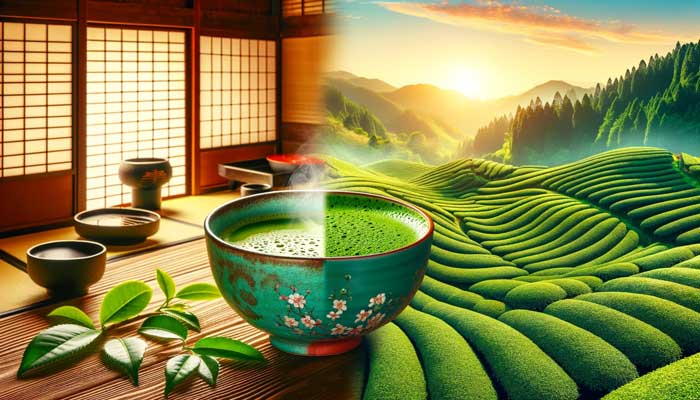In recent years, matcha, a finely ground powder made from specially grown and processed green tea leaves, has seen a surge in global popularity, not just as a health supplement but also as a versatile culinary ingredient. Amidst this rising interest, a particular debate has captured the attention of tea enthusiasts and health-conscious consumers alike: the comparison between Japanese matcha and Chinese matcha.
While both varieties share certain fundamental characteristics, they also possess unique qualities and histories that distinguish them from one another. In this exploration, we delve into the nuances of Japanese matcha vs Chinese matcha, aiming to uncover the differences and similarities between these two esteemed forms of matcha.
We will investigate their origins, production methods, flavor profiles, health benefits, and the reasons behind their varying market presence and pricing. This comprehensive comparison aims to provide a clearer understanding of what sets these two types of matcha apart, and why each holds a special place in the world of tea connoisseurs and casual drinkers alike.
Table of Contents
Overview of Matcha

Matcha is a type of green tea that is finely ground into a powder, celebrated not only for its rich flavor but also for its historical and cultural significance. Unlike other tea varieties, matcha involves the consumption of the entire tea leaf in powdered form, which contributes to its unique nutritional properties and intense flavor.
Historical Significance of Matcha:
- Originating in East Asia, matcha has been an integral part of traditional tea ceremonies for centuries, particularly in Japan.
- It is closely associated with Zen Buddhism, where it was used to aid in meditation due to its calming effects while also providing alertness, thanks to the presence of L-theanine and caffeine.
- Matcha’s preparation and consumption have evolved into a ceremonial art, reflecting principles of respect, purity, tranquility, and harmony.
Brief History in Japan:
- Matcha was introduced to Japan from China by Buddhist monks in the 12th century.
- It became an essential part of Japanese culture, especially among samurai and eventually, all social classes.
- The Japanese tea ceremony, known as Chanoyu, Sado, or simply Ocha, centers around the preparation, serving, and drinking of matcha.
- Over the centuries, Japan has developed unique cultivars and refining techniques, leading to the high-quality matcha known today.
Brief History in China:
- In China, the origins of matcha can be traced back to the Tang Dynasty (618–907), where tea leaves were steamed and formed into bricks for storage and trade.
- It was during the Song Dynasty (960–1279) that the method of making powdered tea from these bricks, and whipping it in hot water, became popular – a practice that was a precursor to the Japanese matcha tradition.
- While matcha’s popularity declined in China with the emergence of loose-leaf tea, it maintained its significance in certain Buddhist monasteries.
- Modern-day China has seen a resurgence in matcha production, though its approach and flavor profile differ from the Japanese tradition.
This historical journey of matcha from China to Japan and its evolution over the centuries highlights the deep cultural and historical roots of this unique beverage. Each country’s approach to growing, processing, and enjoying matcha offers insight into their respective tea cultures and traditions.
[Source: Wikipedia Matcha]
Production Methods
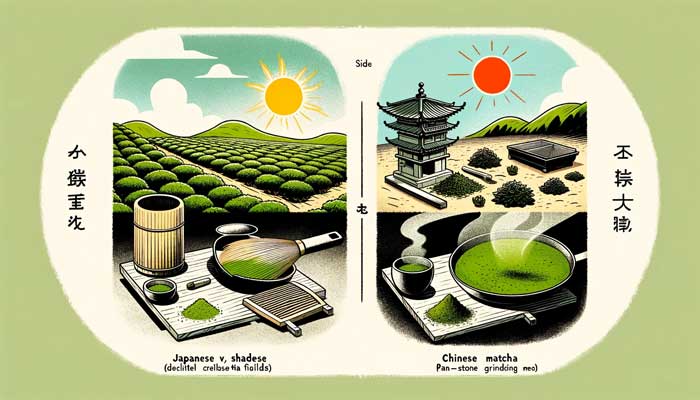
The distinct characteristics of Japanese and Chinese matcha are largely a result of differing cultivation and processing methods. These practices are deeply rooted in each country’s agricultural traditions and have a profound impact on the flavor, color, and overall quality of the matcha produced.
Cultivation Methods:
- Japanese Matcha:
- In Japan, matcha cultivation is a meticulous process. About 20-30 days before harvest, the tea plants are shaded using traditional methods like straw or cloth covers. This shading increases chlorophyll levels, giving Japanese matcha its vibrant green color.
- The finest buds are handpicked, ensuring only the highest quality leaves are selected for matcha production.
- The leaves go through a no-shortcut journey – first, they’re steam-dried, then all the veins and stems are taken out. Why? Because those parts are bitter, and we’re not about that bitter life in our matcha. This step is a game-changer for that smooth, bitterness-free taste.
- Next up, those leaves meet the stone mill. And here’s where patience pays off. The grinding? Super slow. We’re talking snail-paced here, because rushing just heats up the leaves and steals away all the good stuff – the nutrition. This isn’t a race; it’s about preserving every bit of goodness. After about an hour of this slow dance, what do we get? A precious 30 to 40 grams of the finest, nutrient-packed matcha. That’s the UJIHA way – no rush, all quality.
- Chinese Matcha:
- Chinese matcha, on the other hand, is not always shaded before harvest, leading to a lighter green color. The focus is less on the specific leaf grade and more on the overall yield.
- The leaves may be machine-harvested, which can affect the delicacy of the final product.
Processing Methods:
- Japanese Matcha:
- After harvesting, the leaves are steamed to halt fermentation, preserving the color and nutrients. This steaming process is a key element that differentiates Japanese matcha from its Chinese counterpart.
- The leaves go through a no-shortcut journey – then all the veins and stems are taken out. Why? Because those parts are bitter, and we’re not about that bitter life in our matcha. This step is a game-changer for that smooth, bitterness-free taste.
- The steamed leaves are then dried and aged in cold storage to deepen the flavor. The final step involves a slow and careful grinding process using a stone mill. And here’s where patience pays off. The grinding? Super slow. We’re talking snail-paced here, because rushing just heats up the leaves and steals away all the good stuff – the nutrition. This isn’t a race; it’s about preserving every bit of goodness. After about an hour of this slow dance, what do we get? A precious 30 to 40 grams of the finest, nutrient-packed matcha. That’s the UJIHA way – no rush, all quality.
- Chinese Matcha:
- In China, the leaves are typically pan-fired, a method common in Chinese tea processing. This step imparts a slightly roasted, nuttier flavor compared to the fresh, vegetal taste of Japanese matcha.
- The grinding process in China may be faster and less refined, leading to a coarser texture.
Impact on Flavor, Color, and Quality:
- The shading and meticulous processing methods in Japan produce matcha with a rich, vibrant green color, a finer texture, and a delicate balance of sweetness and umami.
- The lack of shading and different processing techniques in China result in matcha with a more varied color spectrum, a bolder flavor profile, and a slightly coarser texture.
- These differences also influence the quality grades of matcha. Japanese matcha, particularly the ceremonial grade, is often higher in quality due to its labor-intensive production, resulting in a smoother and more flavorful experience.
- The diverse processing methods reflect the unique tea cultures of each country and contribute to the distinct identities of Japanese and Chinese matcha.
Is Japanese Matcha Better than Chinese Matcha?
The question of whether Japanese matcha is superior to Chinese matcha is subjective and largely depends on individual preferences and the specific qualities one values in tea. However, there are notable differences in taste, texture, and quality, influenced by factors such as climate, soil, and artisanal techniques, which can guide consumers in making their choice.
Differences in Taste:
- Japanese Matcha: Known for its delicate sweetness and rich umami flavor, Japanese matcha offers a smooth, creamy taste with subtle vegetal notes. This unique flavor profile is attributed to the shading of tea plants, which increases amino acids like L-theanine.
- Chinese Matcha: Often exhibits a stronger, more astringent taste with nuttier and sometimes slightly roasted undertones. This is a result of the pan-firing process and less emphasis on shading, which impacts the chemical composition of the leaves.
Texture Variations:
- Japanese Matcha: Tends to have a finer, more powdery texture due to the traditional stone grinding techniques. This results in a silky smooth consistency when whisked, creating a frothy, well-integrated beverage.
- Chinese Matcha: May have a coarser texture because of different grinding methods. The coarser grind can sometimes lead to a less homogeneous mix and a slightly grittier mouthfeel.
Quality and Artisanal Techniques:
- Japanese Matcha: The production of matcha in Japan is often characterized by meticulous artisanal techniques passed down through generations. This includes precise control over the growing conditions, careful selection of leaves, and a labor-intensive grinding process. These factors contribute to the high quality and consistent characteristics of Japanese matcha.
- Chinese Matcha: While quality can vary, the production in China is sometimes more focused on quantity. The pan-firing technique and different cultivation practices can lead to a broader range of quality levels.
Influence of Climate and Soil:
- The terroir, including climate and soil, plays a significant role in the flavor profile of matcha. Japan’s specific regions, like Uji, are renowned for their ideal tea-growing conditions, contributing to the high quality of matcha produced there.
- Chinese matcha benefits from the diverse climates and soil conditions across various regions, which can lead to a wider variety of flavor profiles, though this can also mean more variability in quality.
In conclusion, whether Japanese matcha is “better” than Chinese matcha is a matter of personal taste and preference. Japanese matcha is often praised for its higher quality, smooth texture, and unique flavor profile, while Chinese matcha offers its own distinctive taste and a broader range of experiences. Both varieties have their own merits and can cater to different preferences and uses.
Quality and Purity: Is Matcha Powder from China Good?
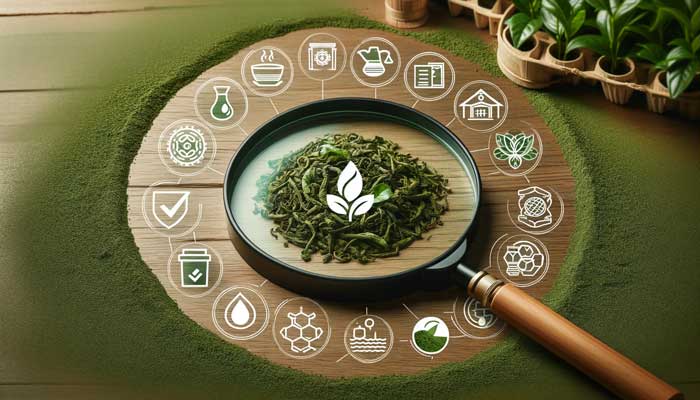
When evaluating the quality and purity of matcha powder from China, it’s important to not only consider the standard quality measures but also to address specific concerns regarding the use of pesticides, including those highlighted in a report by Greenpeace USA and NIH (National Library Of Medicine).
Greenpeace USA Report on Toxins in Chinese Tea:
- According to the report, 11 samples of Chinese tea, including well-known varieties like Tenfu’s Bi Luo Chun tea and jasmine tea from producers like Zhang Yiyuan and Wuyutai, were found to contain methomyl and endosulfan.
- These pesticides are banned for use on tea leaves by China’s Ministry of Agriculture due to their high toxicity. The World Health Organization (WHO) classifies methomyl as highly hazardous due to its acute toxicity. Endosulfan is known for its persistent toxicity and bioaccumulation effect and is banned globally.
- The presence of these banned substances in some Chinese tea products raises significant concerns about the safety and purity of these products, including matcha.
[Source: Pesticide pollution: Chinese tea may not be safe to drink]
NIH Study on Heavy Metal Contamination:
- A comprehensive study from NIH sheds light on the presence of heavy metals in Chinese tea. The study analyzes data from various tea-producing areas in China, noting that heavy metals like lead (Pb), arsenic (As), cadmium (Cd), and mercury (Hg) can accumulate in tea leaves. These heavy metals pose significant health risks, including cardiovascular, immune, and endocrine system diseases, and even cancer.
- Despite some areas maintaining heavy metal concentrations within safe limits, the study found instances of high concentrations of heavy metals, particularly in certain regions and tea types. This variability in heavy metal content across different areas and teas points to a complex interplay of factors, including soil composition, industrial and agricultural development, and local environmental conditions.
- The study emphasizes the importance of understanding the status of heavy metal contamination in Chinese tea and the associated health risks, providing a crucial perspective for consumers and regulators.
Impact on Matcha Quality and Safety:
- These findings from the Greenpeace report and the NIH study indicate that while Chinese matcha can be of good quality, there are significant concerns regarding pesticide residues and heavy metal contamination.
- The variability in adherence to safety standards and the impact of environmental factors like pollution and soil quality can affect the purity and safety of Chinese matcha. This contrasts with the typically more consistent quality control and lower environmental pollution impact in Japanese matcha production.
Comparison with Japanese Matcha:
- Japanese matcha is generally associated with higher quality control, with stringent regulations on pesticide use and lower environmental pollution in major tea-growing regions.
- The meticulous cultivation and processing methods in Japan, along with strict adherence to safety standards, contribute to the high quality and purity of Japanese matcha.
In conclusion, while Chinese matcha offers unique flavors and culinary versatility, concerns about pesticide residues and heavy metal contamination may influence consumer preferences. On the other hand, Japanese matcha, with its stringent quality control and lower environmental contamination, remains a preferred choice for those prioritizing health and safety in their tea selection. The insights from these studies highlight the importance of rigorous quality control and environmental management in tea production, underscoring the need for ongoing monitoring and regulation to ensure the safety and quality of matcha.
Why is Japanese Matcha So Expensive?

Japanese matcha is renowned for its quality, but this high standard comes with a higher price tag. Several factors contribute to the costliness of Japanese matcha, ranging from labor-intensive farming practices to stringent quality control and export costs. Understanding these elements helps explain why Japanese matcha is often more expensive than its counterparts.
Labor-Intensive Farming:
- The production of Japanese matcha is highly labor-intensive. The shading of tea plants, a crucial step in developing matcha’s unique flavor profile, requires precise timing and manual labor.
- The process of hand-picking the young tea leaves is meticulous and time-consuming, as only the finest leaves are selected for matcha production.
- These labor-intensive practices ensure the highest quality but also contribute significantly to the overall cost of the product.
Quality Control Measures:
- Japanese matcha undergoes rigorous quality control at every stage of production. This includes careful monitoring of the tea plants, precise processing methods, and thorough testing of the final product.
- The commitment to maintaining high standards of quality means additional costs in terms of both time and resources, impacting the final price of the matcha.
- The focus on quality over quantity means that less matcha is produced compared to more commercial tea products, contributing to its premium status and price.
Processing and Grinding Techniques:
- The grinding process is carefully and deliberately slow, yielding only 30 to 40 grams of matcha per hour. This cautious approach ensures that the nutrients are fully preserved, prioritizing the quality of the matcha over the quantity produced. This slow grinding process is more costly than faster, industrial methods.
- The expertise required to operate these mills and the time taken to grind small batches also add to the cost.
Export Costs:
- Exporting matcha from Japan involves shipping, handling, and customs costs, which add to the final retail price, especially in international markets.
- The packaging standards for export are typically higher to preserve the quality of matcha during transit, which further increases the cost.
Limited Production Areas:
- Matcha production in Japan is concentrated in specific regions like Uji, Kagoshima, and Aichi. The limited geographic areas for cultivation, coupled with Japan’s high land and labor costs, contribute to the higher price of matcha.
- The specific climate and soil conditions in these regions are ideal for growing matcha but also limit the scale of production, making it a more exclusive product.
In conclusion, the high cost of Japanese matcha is a reflection of its artisanal production process, stringent quality control, and the costs associated with exporting a premium product. These factors combined ensure a superior quality product but also contribute to its status as a luxury item in the world of tea.
Culinary Uses and Preferences
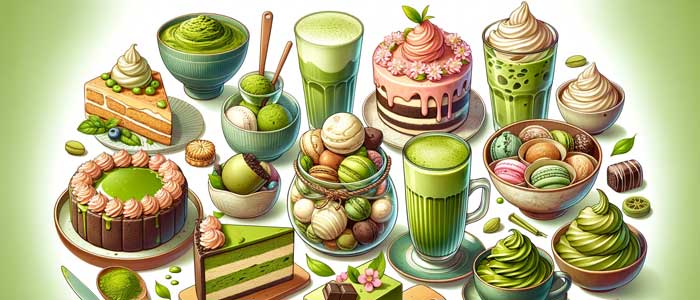
The use of matcha in cuisine extends beyond traditional tea ceremonies, with both Japanese and Chinese matcha finding their way into a variety of culinary creations. The differences in flavor, texture, and quality between Japanese and Chinese matcha influence how they are used in cooking and baking, as well as the preferences of consumers and chefs.
Japanese Matcha in Cuisine:
- Japanese matcha is renowned for its vibrant green color and delicate flavor profile, which includes sweet and umami notes. This makes it highly sought after for use in high-end culinary applications.
- It is commonly used in making traditional Japanese sweets, such as mochi and wagashi, where its subtle flavor complements the sweet ingredients.
- Japanese matcha is also a popular ingredient in modern desserts like matcha-infused cakes, ice creams, and chocolates. Its fine texture ensures a smooth incorporation into these dishes.
- In savory dishes, Japanese matcha can be used as a seasoning or coloring agent, adding a unique flavor and visual appeal to dishes like noodles, rice, and soups.
Chinese Matcha in Cuisine:
- Chinese matcha, with its bolder flavor and sometimes nuttier undertones, is well-suited for stronger-flavored dishes.
- It is often used in baking and cooking where its robust flavor can stand up to other strong ingredients.
- Chinese matcha might be preferred in recipes where the matcha flavor needs to compete with other dominant flavors or where a slightly more astringent taste is desirable.
- It’s also a popular choice for matcha-infused beverages, like smoothies or lattes, where its stronger flavor can be an advantage.
Consumer and Chef Preferences:
- Chefs and consumers choose different types of matcha based on the specific culinary need. Japanese matcha is often the go-to for delicate, high-quality desserts and traditional Japanese dishes where its color and flavor profile are paramount.
- For more robust, everyday cooking and baking, Chinese matcha might be preferred for its stronger flavor and more affordable price point.
- The choice also depends on the desired outcome of the dish. For instance, in dishes where matcha is the star ingredient, the smooth and refined taste of Japanese matcha might be favored. In contrast, in dishes where matcha is one of many flavors, the more assertive profile of Chinese matcha could be more suitable.
The culinary applications of matcha are diverse and continue to evolve as chefs and food enthusiasts experiment with this versatile ingredient. The choice between Japanese and Chinese matcha in culinary uses is influenced by both the characteristics of the matcha and the specific demands of the recipe.
Health Benefits and Nutritional Comparison
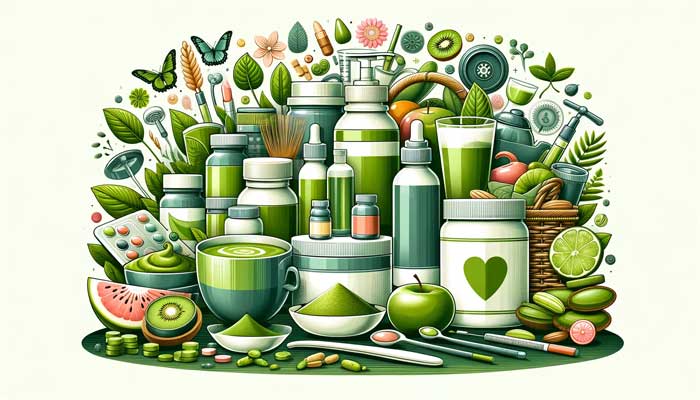
Matcha, whether from Japan or China, is celebrated for its health benefits, which are attributed to its rich content of antioxidants, vitamins, and other beneficial compounds. However, the cultivation and processing methods unique to each country can result in some differences in their nutritional profiles and health benefits.
Antioxidant Content:
- Matcha is renowned for its high levels of antioxidants, particularly catechins like EGCG (epigallocatechin gallate), which are linked to numerous health benefits, including reduced risk of heart disease and certain cancers, and improved brain health.
- Japanese matcha, due to its shading process before harvesting, tends to have higher levels of chlorophyll and EGCG. This is because the shading increases the production of amino acids and antioxidants in the leaves.
- Chinese matcha, while still rich in antioxidants, may have slightly lower levels of EGCG due to different cultivation practices, such as less frequent shading.
Nutritional Variations:
- Both Japanese and Chinese matcha contain vitamins A, C, E, and several B vitamins, along with trace minerals like potassium, iron, and calcium. However, the nutrient levels can vary depending on the soil quality and farming practices in each region.
- The method of processing can also impact the nutrient content. For example, the steaming process used in Japanese matcha production may better preserve certain nutrients compared to the pan-firing method used in China.
Amino Acids and Flavor Compounds:
- Matcha is known for containing L-theanine, an amino acid that promotes relaxation without drowsiness and enhances concentration. Japanese matcha typically has higher levels of L-theanine, contributing to its unique umami flavor and calming effects.
- The differences in cultivation and processing between Japanese and Chinese matcha can lead to variations in other flavor compounds, which might have subtle effects on their health benefits.
Impact of Pesticides and Organic Farming:
- The health benefits of matcha can be influenced by the use of pesticides and the adoption of organic farming practices. Organic matcha, whether from Japan or China, is likely to have lower pesticide residues, which is preferable for health-conscious consumers.
- Japanese matcha often has strict regulations regarding pesticide use, and many farms adhere to organic farming practices, potentially making it a safer choice in terms of chemical exposure.
In summary, both Japanese and Chinese matcha offer significant health benefits, mainly due to their high antioxidant content. However, Japanese matcha may have a slight edge in terms of certain nutritional aspects like chlorophyll, EGCG, and L-theanine content, largely due to its unique shading and processing techniques. Nonetheless, both varieties provide a nutritious and healthful addition to any diet, with their distinct cultivation and processing methods contributing to their individual health profiles.
Conclusion

This detailed exploration of Japanese and Chinese matcha has revealed a nuanced landscape shaped by a blend of historical, cultural, agricultural, and environmental factors. Each variety of matcha, with its unique cultivation and processing methods, offers a distinct experience in terms of flavor, texture, quality, and health implications.
Key Points:
- Historical and Cultural Context: Matcha’s journey from China to Japan and its evolution in both countries highlights its deep cultural and historical roots.
- Cultivation and Processing: The shading, picking, and grinding processes in Japan contribute to the high quality of Japanese matcha, characterized by its vibrant color and delicate flavor. In contrast, Chinese matcha, with varying cultivation methods, presents a broader range of flavors and textures.
- Environmental Concerns: The Greenpeace USA report and NCBI study bring to light significant issues regarding pesticide use and heavy metal contamination in Chinese tea, affecting the overall quality and safety of Chinese matcha.
- Health Implications: While both Japanese and Chinese matcha offer health benefits, concerns about contaminants in Chinese matcha may influence consumer preferences, with Japanese matcha generally perceived as safer due to stricter quality control and lower environmental pollution.
- Consumer Choice: The choice between Japanese and Chinese matcha will depend on individual preferences for flavor, as well as concerns about health, environmental impact, and quality assurance.
- Japanese Matcha: It stands out for its meticulous cultivation process, strict quality control, and the lesser impact of environmental pollutants, contributing to its reputation for higher quality and purity. Its unique flavor profile, ceremonial significance, and health benefits make it a preferred choice for many tea enthusiasts.
- Chinese Matcha: While offering its own unique taste and texture, Chinese matcha’s quality and purity can vary due to factors like regional environmental pollution, the varying adherence to organic farming practices, and concerns about pesticide residues and heavy metal contamination. Nonetheless, it remains a valuable and versatile ingredient in both culinary and health-focused applications.
The addition of insights from the Greenpeace USA report and the NCBI study into heavy metal and pesticide contamination in Chinese tea adds a critical dimension to our understanding. These findings highlight significant concerns about the safety and purity of Chinese matcha, emphasizing the need for stringent quality controls and robust environmental management in tea production.
As we conclude this comparison, it becomes evident that both Japanese and Chinese matcha have their distinct places in the tea world, each influenced by their respective cultural histories and contemporary practices. For consumers and connoisseurs, the choice between Japanese and Chinese matcha will be informed not only by flavor preferences but also by considerations of health, environmental impact, and quality assurance. Understanding these nuances encourages a more informed and conscientious approach to enjoying and appreciating the rich world of matcha.

